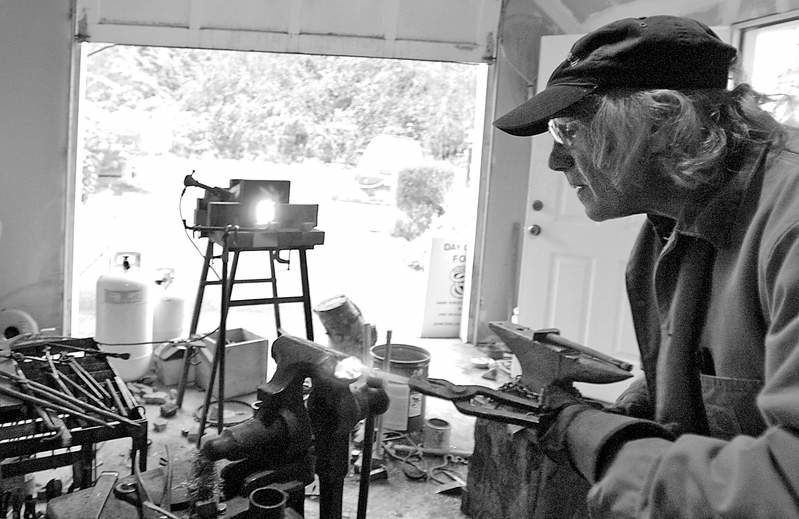Blacksmiths reconnect with past
Published 4:00 am Monday, January 12, 2009

- John Shields ties a knot with a red-hot steel bar in November in his workshop garage in University Place, Wash. The 61-year-old Shields, a tool and die designer for Boeing, carries on an ancient tradition that he said gave rise to his modern occupation.
TACOMA, Wash. — It’s a sound that’s echoed through the centuries since antiquity. It’s the clang of a hammer striking red-hot metal laid upon an anvil.
You hear that sound as you walk up the driveway of John Shields’ home in University Place. Within sight of the Day Island Bridge, the 61-year-old Shields, a tool and die designer for Boeing, carries on an ancient tradition that he said gave rise to his modern occupation.
Standing at his anvil, a 100-year-old antique, beside a homemade forge roaring in his garage workshop, Shields said: “This is going back to the grass roots. That’s what really turns me on about it, because it takes you right back to the beginning, to the mother of the trade.”
He made his first forged object, a fireplace poker, in metal shop as a student at Mason Junior High School in Tacoma.
Blacksmiths, Shields said, “were actually the first generation of machinists, and tool and die makers. Anything in iron, they manufactured.”
He caught the blacksmithing bug at an early age. He caught it from his father, Beverly Gordon Shields. “He was a journeyman tool and die maker, and a blacksmith, too, and when I was a little kid, I was drug around to every machine shop here in Tacoma that he knew.”
His late father’s photo hangs on the wall of his workshop, and his toolbox rests upon a shelf there. The feeling that a legacy is being honored is strong.
Working at the forge “gives you a sense of a link to your ancestors,” Shields said. “I’m Irish. My dad was Irish. We’re Celts, and they were great ironworkers.”
And as his father’s legacy was passed down to him, Shields is passing it on to the next generation. His daughter, Adawnya Shields, a pipefitter by trade, has been learning the blacksmith craft from him as an apprentice for about four years.
Blacksmithing went into a long decline beginning in the mid-19th century as factories produced more and more items traditionally made by smiths. The decline accelerated in the early 20th century as automobiles made the horse and buggy obsolete.
With the demand for iron wagon-wheel rims and horseshoes drying up, the craft withered. But it never entirely died out. And in the early 1970s, it began to revive, said Darryl Nelson, of Eatonville.
Nelson, 55, is one of the founders and a past president of the Northwest Blacksmith Association, a trade organization that takes in Washington, northern Oregon, western Idaho and Vancouver, B.C. It has more than 600 members, Nelson said. Most are hobbyists, like Shields, pursuing the craft in their spare time.
Around 60 are full-timers, Nelson said. He’s one of them and has been for 35 years.
Nelson got his start in blacksmithing at age 19 when he enrolled in the farrier program at an Olympia trade school. A farrier is someone who makes and fits horseshoes.
A farm boy from North Dakota, Nelson at first thought he wanted to be a veterinarian. But then he decided he didn’t want to spend seemingly endless years in schools learning the profession. Farriers, he said, don’t just make horseshoes but also do some pathological work to keep horses and their hooves healthy. And training in that lasted only four months, he said.
One of his classmates was a man who had studied at Turley Forge, a renowned blacksmithing school in New Mexico.
From him, Nelson learned that there was more to blacksmithing than horseshoes. He learned it could be not just a trade but an art form. He was hooked.
Today, at Fire Mountain Forge, his blacksmith shop in Eatonville, he earns a living making fireplace implements, andirons and pokers, and railings and chandeliers. The fireplace tools are adorned with hand-forged animal heads. Nelson said he’s made thousands.
“Mountain goat heads, bear heads, ram’s heads, bison heads, deer, elk, lynx, cougar, wolves, dogs.” Even warthogs. “There aren’t many animals at this point I haven’t forged,” he said.
He’s sold many of these items to lodges, with Timberline Lodge in Oregon and Skamania Lodge in Washington being among his biggest customers. When lodge guests saw his work and began placing private orders, his business really took off.
“It’s not just a job, it’s a love,” he said of the attractions of modern-day blacksmithing.
“At the end of the day, you see what you’ve spent your day doing. It’s not a pile of papers in the corner of a desk. It’s actually something that has significant weight to it and a use.”
Since the ’70s, Nelson has taught classes in the craft of blacksmithing. In the last five years, he’s taught them at a school he runs on his Eatonville property called Meridian Forge.





